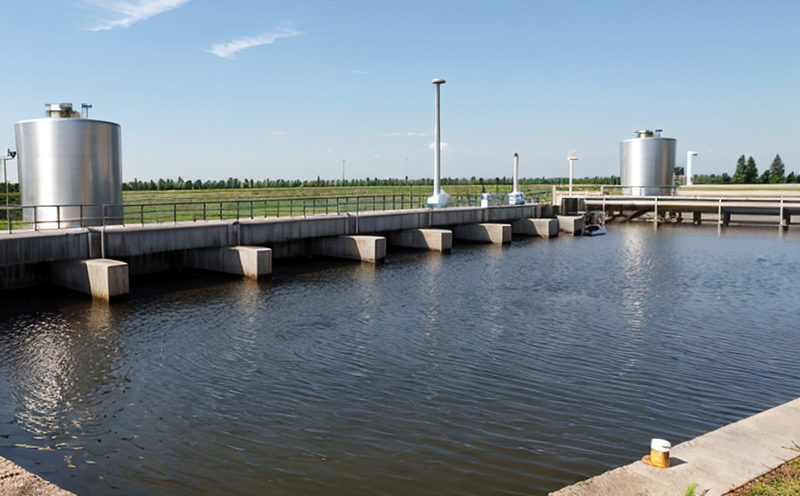EN 12260 Nitrate Reductase Activity Testing in Water Bacteria
The European Standard EN 12260 specifies a method for determining the nitrate reductase activity of water bacteria. This test is crucial for understanding how certain microorganisms convert nitrate into nitrogen gas, which can influence both environmental and public health aspects.
Water pollution from agricultural runoff, industrial discharges, and sewage can lead to elevated levels of nitrate in aquatic environments. Microbial communities play a vital role in the biogeochemical cycling of nutrients like nitrogen. By measuring nitrate reductase activity, we gain insights into the microbial community's capacity for denitrification.
Denitrification is a key process in removing excess nitrates from water bodies. High levels of nitrates can lead to eutrophication, which depletes oxygen and harms aquatic life. The EN 12260 test helps determine the potential for this microbial activity within specific bacterial strains.
The methodology involves inoculating a culture medium containing nitrate as the sole nitrogen source with water samples or isolated bacteria. The presence of nitrite, which is produced during the denitrification process, indicates active nitrate reductase activity. This test allows for quantification and comparison of bacterial strains' abilities to perform this crucial environmental function.
This standard is widely recognized in sectors such as water treatment, wastewater management, and environmental research. Compliance with EN 12260 ensures that water quality standards are met, which is vital for preventing harmful algal blooms and safeguarding public health.
Water utilities, industries discharging into surface waters, and researchers studying microbial ecology all benefit from this testing method. By ensuring compliance, these entities contribute to sustainable practices in environmental management.
Scope and Methodology
The EN 12260 standard defines a quantitative procedure for measuring the nitrate reductase activity of water bacteria. The test uses a colorimetric assay to detect the conversion of nitrate (NO₃⁻) into nitrite (NO₂⁻), which is indicative of the bacterial enzyme's activity.
The process begins with the preparation of nutrient agar plates containing sodium nitrate as the sole nitrogen source. These plates are then inoculated with water samples or isolated bacteria. Incubation under controlled conditions allows for optimal growth and expression of nitrate reductase activity.
Following incubation, a colorimetric substrate is added to the plated samples. This substrate reacts specifically with nitrite ions produced during the denitrification process, resulting in a visible color change that correlates with the amount of nitrite present. The intensity of this color change directly reflects the level of nitrate reductase activity.
The assay provides quantitative results through calibration against known standards. This allows for direct comparison between different samples or bacterial strains, making it an invaluable tool in environmental monitoring and research.
Industry Applications
| Industry Sector | Application |
|---|---|
| Water Treatment Facilities | Evaluating bacterial communities' capacity for denitrification, ensuring compliance with water quality standards. |
| Agricultural Runoff Management | Assessing the effectiveness of mitigation strategies to reduce nitrate pollution in surface waters. |
| Wastewater Treatment Plants | Monitoring denitrification efficiency and optimizing treatment processes for better nutrient removal. |
| Environmental Research Institutions | Studying microbial ecology, particularly in relation to nitrogen cycling and its impact on aquatic ecosystems. |
| Pharmaceutical Industries | Ensuring compliance with environmental regulations regarding waste discharge into water bodies. |
| Food Processing Plants | Verifying the safety of wastewater treatment processes to prevent contamination of potable water supplies. |
| Oil and Gas Extraction Facilities | Monitoring for potential sources of nitrate pollution from operational activities. |
Eurolab Advantages
EuroLab provides state-of-the-art facilities and experienced personnel dedicated to delivering precise and reliable EN 12260 nitrate reductase activity tests. Our team of experts ensures that all samples are processed according to the latest international standards, providing accurate results essential for regulatory compliance.
Our advanced laboratory equipment, including high-resolution spectrophotometers, guarantees consistent and reproducible test outcomes. This precision is critical in environments where even small variations could lead to significant discrepancies in environmental impact assessments or health risk evaluations.
EuroLab offers comprehensive support for regulatory submissions, helping clients navigate complex compliance requirements efficiently. Our services extend beyond just testing; we provide expert advice on best practices and strategies to enhance your environmental management programs.





